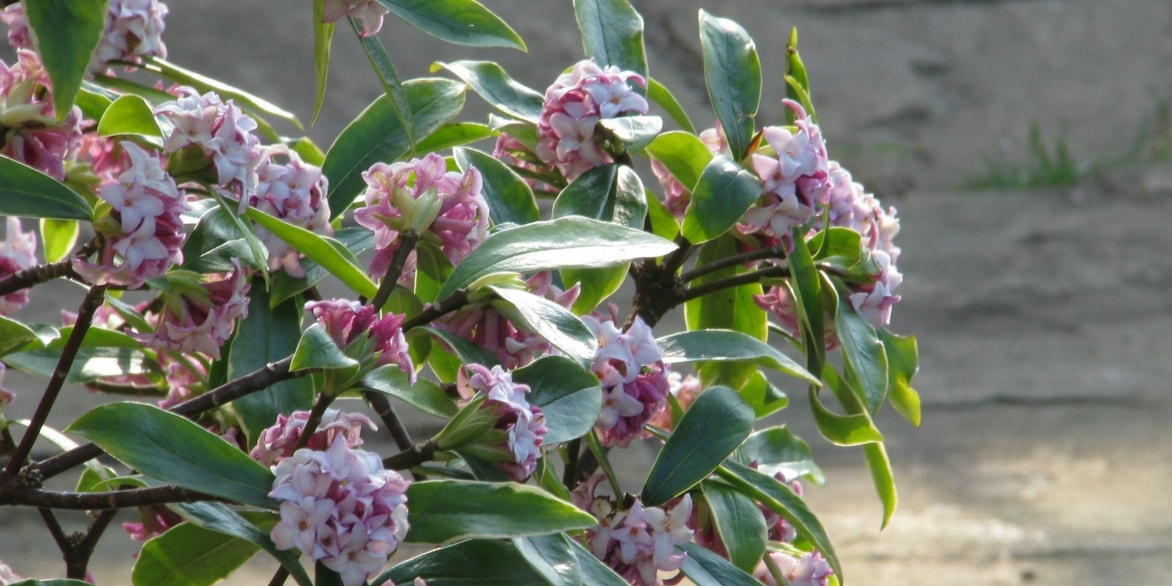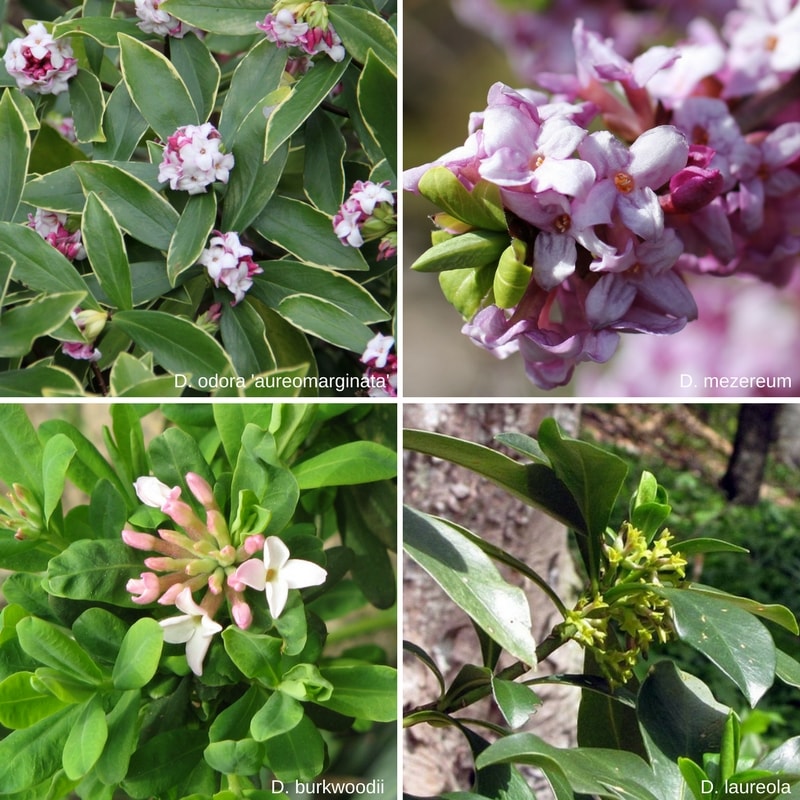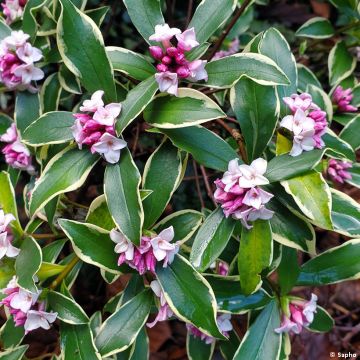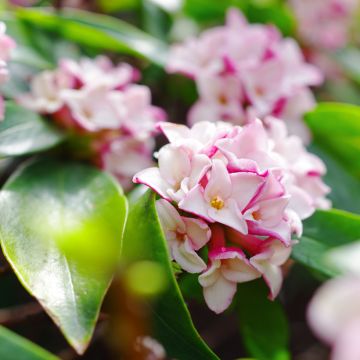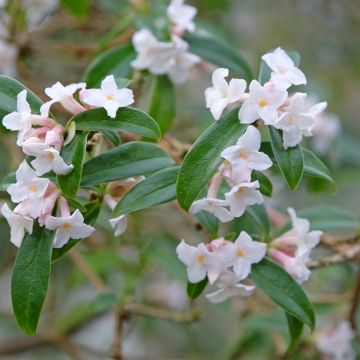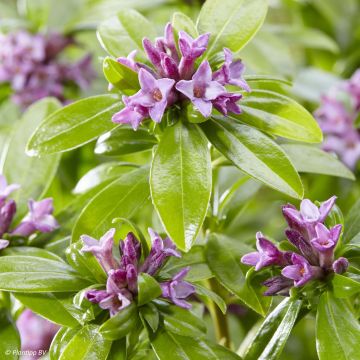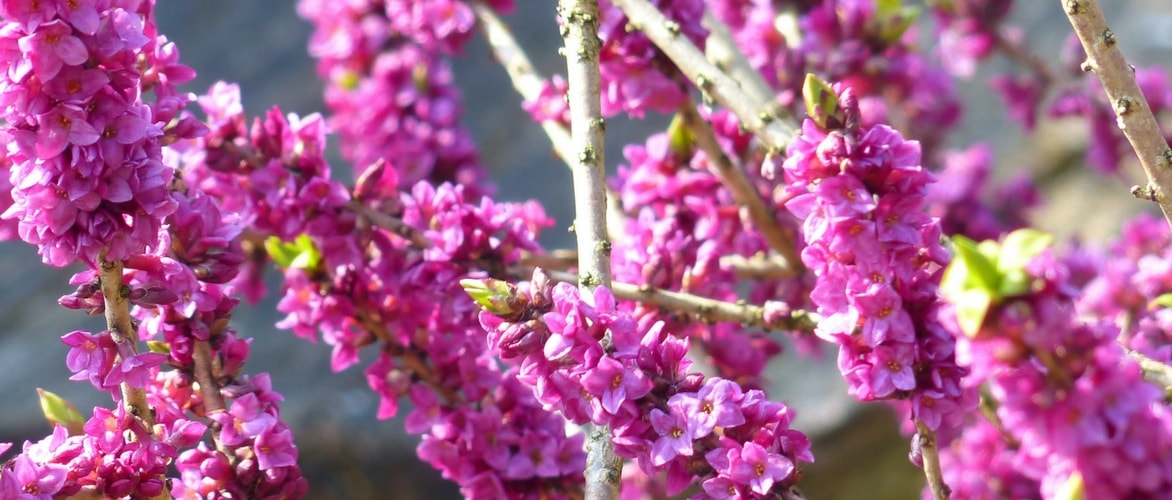
Daphne: planting, growing and care
Contents
Daphne in a nutshell
- In the depths of winter, its flowers exude a powerful fragrance that fills the garden for 20 metres around
- Its glossy green foliage is evergreen, semi-evergreen, or deciduous depending on the species
- It is a must-have for shady or semi-shady gardens
- It requires cool, humus-bearing, and well-drained soil, and needs a bit of attention as it is sensitive to excess water
- With very slow growth and being low-maintenance, it is well-suited for small gardens, urban gardens, and grows very well in pots
A word from our expert
Daphne, also known as the lovely wood or gentle wood, is a hardy bush with delicate star-shaped flowers, white or pink, that exudes an exceptional fragrance.
If Daphne gets its name from the nymph of Greek mythology who was transformed into a laurel tree, it is because its divine scent captivates to the point of enchantment.
Indeed, Daphne odora, the most fragrant of all Daphnes, releases a very floral fragrance that evokes, depending on the nose, carnation, jasmine, or even hyacinth, all mingled with citrus and spiced with a hint of clove. A deliciously complex scent that spreads several metres around!
Still relatively unknown, Daphnes are part of, along with Sarcococca and Hamamelis, the few fragrant bushes in winter. And while Daphne mezereum blooms early as February, others like Daphne (x) transatlantica wait until June.
But this generous flowering is not its only asset! Its shiny, leathery foliage can remain evergreen in a mild winter.
Relatively accommodating in light, acidic, well-drained soil, Daphne grows in the shade of trees, sheltered from stagnant moisture, cold winds, and intense heat.
With very slow growth, it is a compact bush that fits well in small gardens and urban gardens. Its quite heterogeneous family includes dwarf varieties, ideal for cool rockeries, and tall species that can reach up to 1.5 metres high and wide.
Its moderate size and compact silhouette allow for numerous uses: in borders, hedges, flower beds, as ground cover, and even in pots.
While the ideal spot to enjoy its powerful fragrance is close to the house, it would also be perfect for filling neglected and shaded areas, where few plants bloom. It can be combined with shade plants and heather soil plants, as well as with more contrasting foliage: camellias, ferns, hamamelis, skimmias, aucubas, or azaleas, and with hellebores, snowdrops, crocuses, and daffodils.
In winter or spring, Daphne enchants the garden, exuding a delightful scent. Discover this surprising bush!
Botany
Botanical data
- Latin name Daphne
- Family Thymelaeaceae
- Common name Pretty Wood, Gentle Wood
- Flowering very fragrant, from February to October depending on the varieties
- Height 0.80 to 4 metres
- Exposure Partial shade, shade
- Soil type Heather soil (Acidic), neutral
- Hardiness -15 °C
Daphne, nicknamed “Pretty Wood” or “Gentle Wood”, is a cousin of the “Garou” from our mountains. It is a bush belonging to the Thymelaeaceae family, native to Europe, North Africa, and temperate Asia. It grows in woods and thickets or in mountainous areas.
About fifty species of shrubs with deciduous, evergreen, or semi-evergreen foliage make up the genus, but only a few species are cultivated in France, including: Daphne mezereum, which has excellent hardiness down to -30 °C, Daphne cneorum, a dwarf variety that is equally hardy, Daphne laureola, which remains green in all seasons, Daphne x burkwoodii, a tall species, Daphne alpina, and the most well-known, Daphne odora or fragrant Daphne, which is a protected species in France. The latter is also the most fragrant of the Daphnes, particularly its famous cultivar ‘Aureomarginata’.
Its rather heterogeneous family includes creeping and ground-cover varieties like Daphne cneorum, which does not exceed 20 cm in height at maturity, while tall species like Daphne x burkwoodii can reach up to 1.5 metres wide.
With very slow growth, Daphne is a compact shrub that is well-suited to small gardens. It has a relatively short lifespan for a shrub, lasting 15 to 30 years depending on the varieties.
The habit of this small shrub varies according to the species: open with upright branches, bushy and quite dense and rounded, sometimes spreading or even prostrate. The silhouette, more or less branched, bears thick and flexible branches. Daphne takes a while to settle in: the plant develops its roots very slowly in the soil. Nevertheless, it is not one of those shrubs that you eventually forget: its powerful fragrance knows how to remind us of its presence!
Remarkably floriferous, Daphne flowers, depending on the species and varieties, in winter, spring, or summer. Some are very early and see their flowers open as early as February (Daphne mezereum var. ‘rubra’, Daphne odora ‘Aureomarginata’), while others wait for spring to settle in, in April-May, to show themselves.
It is adorned with delicate small star-shaped flowers with four fleshy, pointed petals that curve outward. They somewhat resemble jasmine flowers. Pink, white, yellow, purple, red, lavender, or lilac, they appear before the leaves and gather at the tips of the bare branches in large umbels that can bear up to thirty flowers. A well-established plant will produce up to 10 flower clusters on each branch.
Most Daphnes are highly fragrant and emit complex scents, both sweet and rustic. These powerful aromas, tinged with exoticism, evoke both carnation, jasmine, hyacinth, enhanced by a spicy hint of clove and citrus notes.
Depending on the varieties, this exceptional flowering may mark a rest period in July-August, then rise more or less discreetly at the end of summer towards September-October, offering flowers for about 6 months of the year. This staggered flowering perfumes the garden up to 20 m around and lasts several weeks.
The foliage of Daphnes is evergreen, semi-evergreen, or deciduous depending on the species. Alternate, simple, and leathery, smooth to downy, dark green or glossy green, oval to lanceolate, their leaves are a few centimetres long for dwarf species or nearly 10 cm for the tallest species. Ranging from 1 to 2.5 cm wide, they are grouped in rosettes at the tips of the branches and then spread along the length of the year’s stems. For some cultivars, this lovely dark green foliage will be variegated or marginate with yellow. For others, it will be very bushy and reminiscent of laurel.
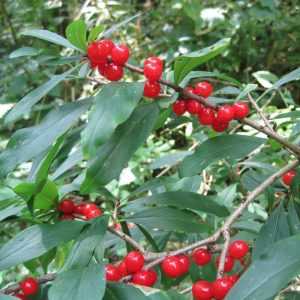
The fruits of Daphne: toxic berries
The red, poisonous fruits develop following the flowers on the leafless branches of the previous year: these decorative berries bright red like currants, white, orange, or black-purple are toxic if ingested. They can be confused with fruits, so we draw your attention to this fact if you have young children.
This undergrowth thrives in partial shade and prefers shaded areas or indirect sunlight filtered by trees. Daphne laureola tolerates deep shade. Daphnes are perfect for gardens exposed to the north or northeast. A spot protected from spring frosts and cold winds is ideal.
It settles almost everywhere in France, except perhaps in a Mediterranean climate: it fears excessive heat and burning sun. It will thrive very well in a mild and humid climate, such as that of Brittany.
Although Daphne generally shows good hardiness (it can survive frosts of around -10 ° to -15 °C), it is better to protect it from severe cold. Intense frost can cause the foliage to drop until new leaves appear in spring.
Less capricious than Kalmia but more vulnerable than Sarcococca, Daphne is not very complicated to cultivate… as long as it is planted in a soil that suits it: light and acidic. It will then flower for many years without requiring maintenance. It prefers well-drained, cool, and light soils. Very sensitive to excess water, it fears the stagnant moisture of heavy, compact, suffocating soils. A soil that is rather neutral or slightly acidic, rich in humus but not overly so suits it very well. The species D. mezereum or D. cneorum accept limestone, while D. odora is typical of heather soil.
Remember above all that it is a lover of moderation: a soil that is not too wet but not too dry either, some sun but slightly shaded, a humus-rich soil but not fertilised with large amounts of manure… With it, everything is a matter of balance!
Read also
Daphne: how to care for it?The different species
There are about fifty varieties of Daphnes worldwide, but only a few species in France, which can be divided into low-growing dwarf Daphnes and taller species.
Dwarf Daphnes
The dwarf species (10-50 cm tall), compact, are perfect for fresh rockeries or pot cultivation:
- Daphne alpina or Alpine Daphne: This is a deciduous species, very hardy, that lives in the limestone rocks and mountains of the Jura, the Alps, and the Pyrenees. Its fragrant white flowers appear from April to June after the leaves. It has a low habit of 20 to 50 cm.
- Daphne cneorum or Alpine Thyme-leaved Daphne: This low bush is characterised by its prostrate form and fine evergreen foliage, not exceeding 30 cm in height. In April-May, clusters of carmine pink flowers with a strong clove scent appear.
- Daphne sericea: With its compact or spreading, rounded habit and evergreen foliage, it is perfect for the edge of a flower bed or in a rockery. In May, flowers with a clove scent, initially purple-pink, lighten towards the end of flowering.
- Daphne arbuscula: This semi-prostrate dwarf bush (10-15 cm tall) has evergreen leaves and abundantly flowering dark pink branches in May-June.
- Daphne jasminea: A semi-prostrate, highly branched and evergreen species that bears delicate, fragrant white star-shaped flowers.
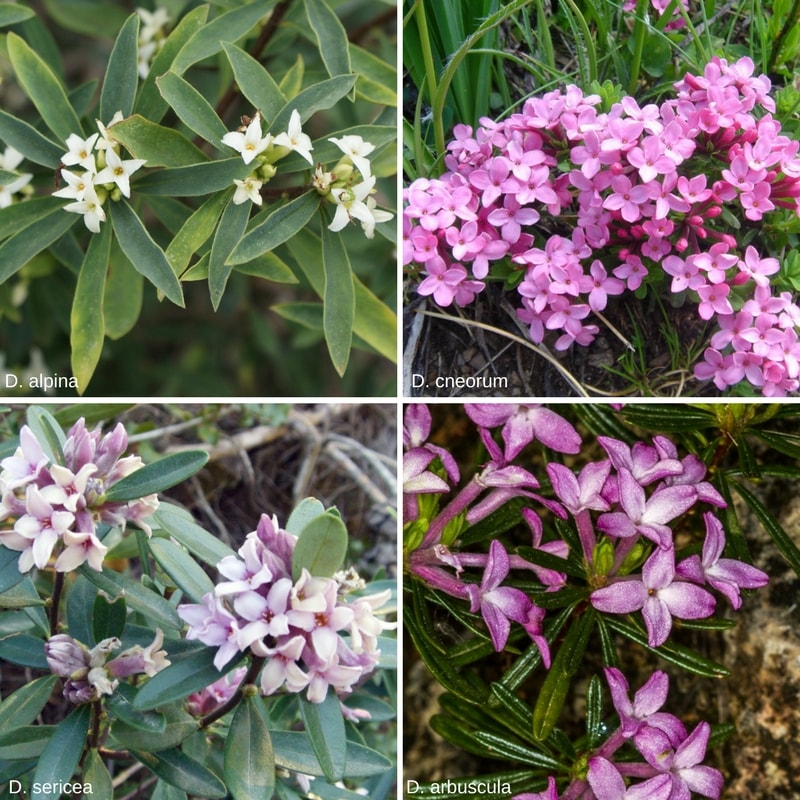
Different species of dwarf Daphnes
Tall Species
They are perfect for heather beds or as solitary plants, but to enjoy their fragrance, it is wise to place them near the house or a path.
- Daphne odora or Fragrant Daphne: This is the most fragrant and one of the earliest Daphnes. This bush, 1.20-1.50 m tall, with a spreading habit, produces very fragrant pink flowers at the tips of the branches from January to March. It is very sensitive to frost: its evergreen foliage does not survive harsh winters. Daphne odora is reserved for mild climates. It comes in varieties with white flowers Daphne odora ‘Alba’ or with gold-margined leaves and light pink to purple-pink flowers Daphne odora ‘Aureo Marginata’. This cultivar can withstand -10 °C, making it an excellent heather soil plant for north or north-east exposure.
- Daphne mezereum: Smaller than Daphne odora, as it does not exceed one metre, it is, however, quite hardy. Before the deciduous leaves appear, it adorns itself from late February to March with upright clusters of lilac-pink flowers, which are also very fragrant. The flowers are concentrated only on part of the length of the branch, giving the plant a unique appearance. It bears red fruits in summer. Daphne mezereum ‘Rubra’ is the most famous of its cultivars: it has purple-pink flowers with an intoxicating scent.
- Daphne x burkwoodii: A compact bush with semi-evergreen foliage, it is one of the largest, reaching up to 1.50 m. Its fragrant light pink flowers appear in May. It is vigorous and very hardy.
- Daphne laureola or Wood Laurel: It can measure from 40 cm to nearly 1.20 m. The interest lies in its very decorative foliage, remaining green and glossy regardless of the season. Its yellow-green flowering lasts a long time.
Discover other Daphne
View all →Available in 0 sizes
Available in 2 sizes
Available in 1 sizes
Available in 1 sizes
Available in 1 sizes
Available in 1 sizes
Available in 3 sizes
Available in 1 sizes
Available in 2 sizes
Available in 1 sizes
Varieties
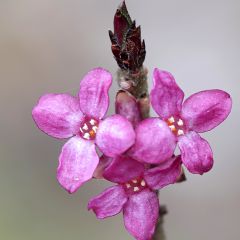
Daphne mezereum var. rubra
- Flowering time March, April
- Height at maturity 1,20 m
/
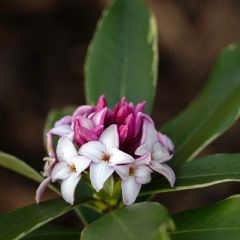
Daphne odora Aureomarginata
- Flowering time March, April
- Height at maturity 1,50 m
/
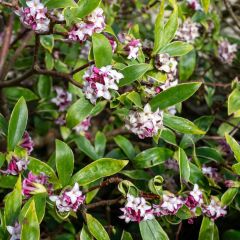
Daphne Perfume Princess
- Flowering time February to May
- Height at maturity 1,20 m
/
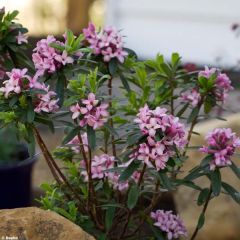
Daphne x bholua Spring Beauty
- Flowering time June to November
- Height at maturity 80 cm
/
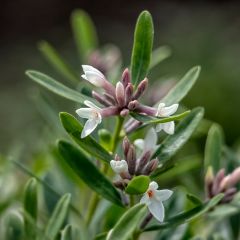
Daphne transatlantica Eternal Fragrance Blafra
- Flowering time June to December
- Height at maturity 80 cm
/

Daphne odora Aureomarginata
- Flowering time March, April
- Height at maturity 1,50 m
/

Daphne transatlantica Eternal Fragrance Blafra
- Flowering time June to December
- Height at maturity 80 cm
/
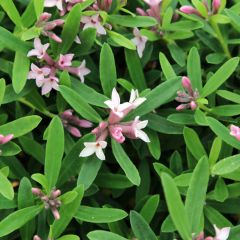
Daphne burkwoodii Somerset
- Flowering time June, July
- Height at maturity 1,50 m
/>
Read also
10 fragrant and scented plantsPlanting
Where to plant?
Daphnes can be planted almost anywhere in France, except perhaps in Mediterranean climates, as they are sensitive to both excessive heat and scorching sun. They thrive in mild and humid climates, such as that of Brittany. Slow-growing, the Daphne is a compact bush that is well-suited for small gardens or urban gardens.
Daphne takes time to establish itself. It does not tolerate transplantation well, so it is best to choose a permanent location for it.
It should be grown in a rather shady corner of the garden: it will flourish in partial shade, sheltered from direct sunlight, at the foot of trees that provide beneficial coolness. It prefers an open situation rather than the shelter of a wall: it also needs air. Daphnes are perfect for gardens exposed to the north or north-east.
It is not difficult to cultivate when you have light and rather acidic soil.
Plant it in cool ground but where water never stagnates and sheltered from cold drafts. It enjoys humus-bearing soil, which is neutral or slightly acidic… What it fears are heavy, compact, suffocating soils. Note that some species, such as D. mezereum, adapt perfectly to calcareous soil.
The Daphne can be used both in borders, as well as in isolation or in pots. Plant the taller species in a wooded or sheltered location to fill a hedge, and the shorter plants in rockeries or along the edges of flower beds exposed to partial shade. Plant it near the house to enjoy its fragrance to the fullest.
In pots, it is a lovely decorative subject all year round if you choose compact varieties with evergreen, glossy green foliage such as Daphne alpina, Daphne arbuscula, or Daphne jasminea.
When to plant?
Daphnes are preferably planted in autumn in regions with mild winters or in spring, in the rest of the country, particularly in northern France.
How to plant Daphne?
As Daphnes do not appreciate transplantation, you will only find young plants in nurseries. Planting is very simple but does require a few precautions to ensure its successful establishment:
- Make a wide hole that is at least three times the volume of the root ball.
- Be careful not to break the root ball when placing it.
- If necessary, add gravel to the bottom of the hole to ensure good drainage (its roots do not like stagnant moisture and are particularly sensitive to Phytophthora attacks) of about twenty centimetres at the bottom of the planting hole. Add well-matured compost or heather soil to the garden soil.
- Spread organic mulch or plant small perennials to protect the base and limit watering: it likes its roots to be kept cool during summer.
- Water immediately after planting and during the first two years while it establishes itself, but without overdoing it. A few summer waterings are sufficient in case of prolonged drought once the temperature exceeds 25 °C. Once well-rooted and well-mulched, it is quite resistant to drought.
Container gardening
Daphnes are stunning in pots! It is essential to choose varieties with evergreen foliage and very compact forms such as Daphne alpina, Daphne arbuscula, Daphne jasminea, Daphne petrea. Be sure to provide a rich, fresh, very well-draining soil mix, as it cannot tolerate stagnant moisture. Choose a large container of around thirty litres from the start, as it is a sensitive plant that does not appreciate repotting. In a pot, it cannot withstand even temporary drought. The Daphne needs water all year round when grown in a pot, ensuring to let it dry out for at least 24 hours between waterings in summer. In winter, it can tolerate drier conditions, so space the waterings every three weeks. Fertilisation from the second year of cultivation is beneficial.
→ Learn more about growing Daphne in pots in our advice sheet!
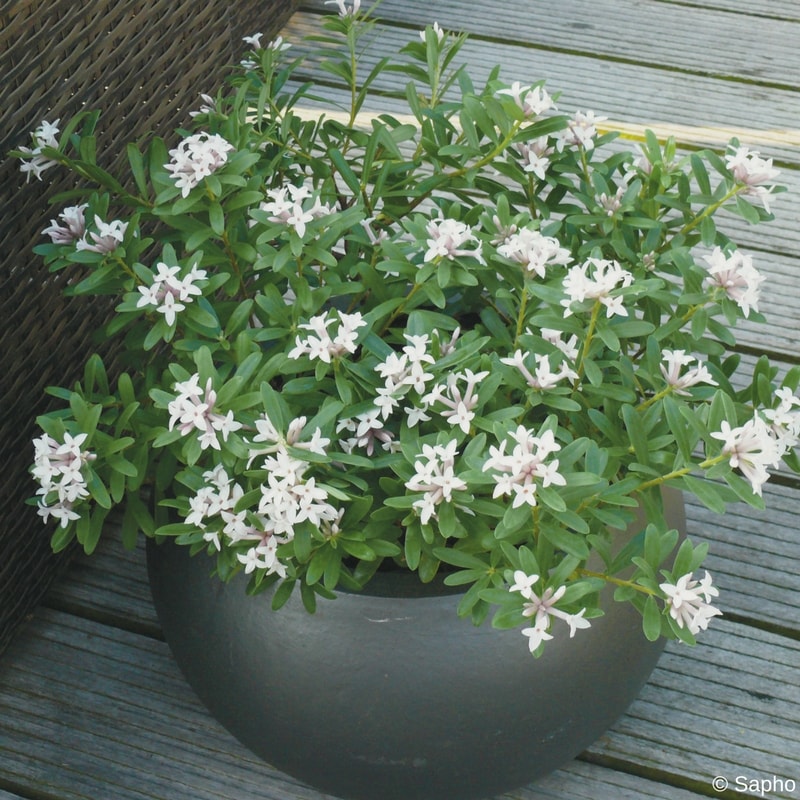
The Daphne ‘Eternal Fragrance’ is well-suited for pot cultivation
Pruning and care
Once the Daphne is well established, it requires very little care. You can maintain the fertility of the substrate by incorporating a little compost each year through superficial scratching at its base. Then, remember to spread a good layer of organic mulch to keep its roots cool during the summer heat.
Slow growing, its pruning is unnecessary. Only intervene to remove any dead branches or to slightly limit its spread. But be careful, know that severe pruning will not be tolerated and could, in the worst case, lead to the death of the entire plant.
Possible diseases
Daphne has a moderate resistance to diseases, particularly fearing cryptogamic diseases caused by fungi. Its main enemy is Phytophthora, a soil-borne fungus whose attack can kill it as suddenly as it is radical.
Phytophthora, literally “plant destroyer” in Greek, thrives in conditions of persistent moisture encouraged by overly frequent watering, combined with temperatures around 15 – 16 °C. Rot enters at the collar and roots, preventing them from performing their essential role of supplying water and nutrients. Consequently, the foliage discolours, browns or reddens, and then dries out. The plant dies quickly. There is no control method, but these issues are rare if cultivation advice is followed: plant in healthy soil, avoid excess water in the soil, and improve drainage. If, despite these precautions, an attack occurs: uproot the affected plants and remove the soil surrounding their roots. Never replant sensitive species in the same spot.
Additionally, Daphne can sometimes fall victim to Marssonina daphnes, a virus that also causes the rapid death of the plant: it is combated by spraying a fungicidal in spring.
Propagation
If your bush bears fruit, you can attempt sowing, but it is a difficult operation to succeed at, which we do not recommend.
- By layering
Layering is the simplest and least tedious method to propagate Daphne, but it is very slow. In spring, lay one of its branches down by bending it towards the ground, burying part of it to encourage rooting. Stake the aerial part. By the end of summer, you can separate the layer from the mother plant if it has enough roots by cutting the stem at the point where it goes into the soil.
- By propagation by cuttings
The lifespan of Daphne can be abruptly shortened by an attack of Phytophthora, so consider taking cuttings regularly. After flowering, in August-September, take semi-woody or semi-hardwood shoots of 10 to 20 cm (that is, from stems that have grown in spring and begin their transformation from softwood to hardwood from July-August). Plant them in a light, well-draining substrate. Regularly moisten the cutting with a spray bottle. Transplant them into buckets as soon as they have formed roots. Winter them in a frost-free environment: a constant temperature of at least 20 °C is essential for rooting in 8 to 10 weeks. Plant them in the ground the following spring.
Associating the Daphne
Plant it alongside early bulbs and semi-shade plants such as ferns, heathers, heucheras, or ophiopogons.
Daphne can be used in borders, as a specimen, or in large pots. Plant the taller species in light shade in a wooded or sheltered location, while the shorter plants (Daphne alpina, Daphne arbuscula, or Daphne jasminea) thrive in cool rockeries or as edging for flower beds. When paired with non-invasive ground cover plants like Pachysandra terminalis, it will benefit from good drought protection. Plant it near the house to enjoy its fragrance to the fullest. It is perfect in a heather soil bed, alongside other daphnes, autumn camellias, deciduous azaleas, and hydrangeas. Create a scene of refinement with a small Japanese maple and ferns… or something very original with Leptospermum ‘Karo Pearl’ and Calycanthus ‘Venus’. At the base, plant heathers and early flowering bulbs (winter aconite, daffodils, crocuses) to create a harmonious and floral carpet.
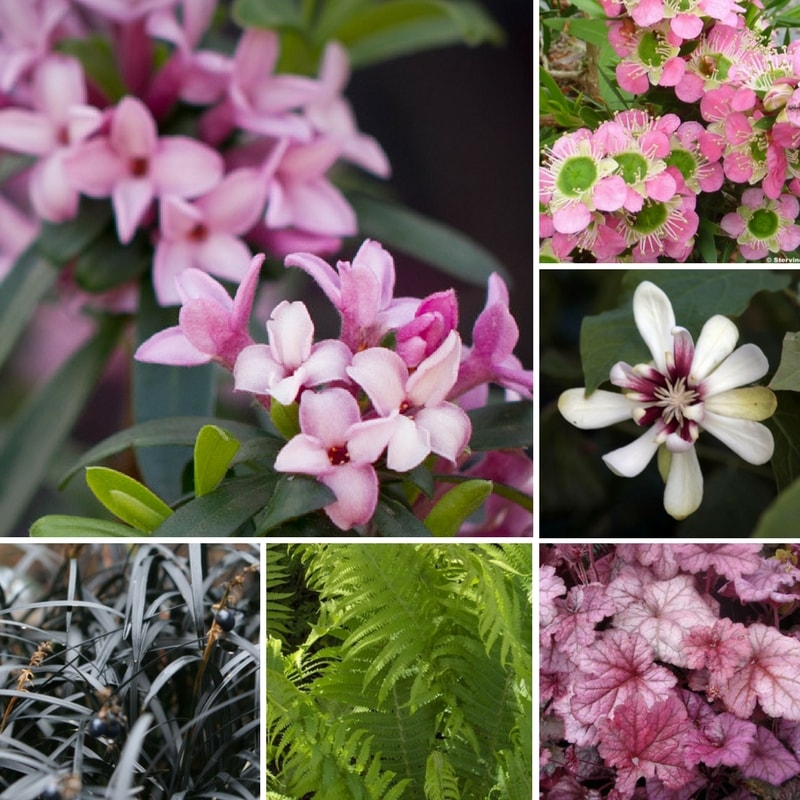
An original combination: Daphne x transatlantica ‘Pink Fragrance’, Leptospermum ‘Karo Pearl Star’, Calycanthus ‘Venus’, and at the base: Ophiopogon planiscapus, Dryopteris filix-mas, and Heuchera ‘Berry Smoothie’
Finally, do not hesitate to bring its wonderful fragrance into the house: the flowering branches are also very beautiful in spring bouquets, mixed with those of Japanese quinces or Prunus.
→ Discover more association ideas with Daphne in our advice sheet!
Useful resources
- Discover our superb range of Daphnes: the most beautiful varieties are with us!
- Our advice sheets: how to plant bushes in heather soil and Daphne odora: how to care for it
- Learn more about toxic bushes in our advice sheet
Frequently asked questions
-
My Daphne looks healthy but isn't shooting, is that normal?
Yes, that's normal. It is one of those plants that takes its time to settle in... and then grows very slowly afterwards. A small drawback that is more than compensated for by its fragrance and the fact that it requires no pruning.
-
My Daphne has lost its leaves after a heavy frost, what should I do?
If the weather is set to be milder in the coming days, water it (but in moderation) and wait: it should recover in spring. In the future, to prevent this unnecessary stress, consider protecting it if the forecasted temperatures drop below -5 °C, as this will help it retain its foliage.
-
Why are the leaves of my Daphne odora turning yellow?
He may well be suffering from chlorosis... The soil is too alkaline for him, it's better to move him and replant... if that's still possible.
-
Is my Daphne losing its leaves after planting serious?
If it only loses a few lower leaves, it's not a big deal. If it worsens, it may well be that the soil is too heavy or that it is exposed to too much direct sunlight. Don't wait too long and move it. If the soil is very well-draining and dry: water it.
-
Can I prune my daphne as it looks a bit visually unbalanced?
A light pruning is advisable, especially to remove dead wood or to give it a nice shape. However, be careful, as it is sensitive at both the base and the branches! Severe pruning may lead to the sudden decline of the shoots, or even the entire plant.
- Subscribe!
- Contents































